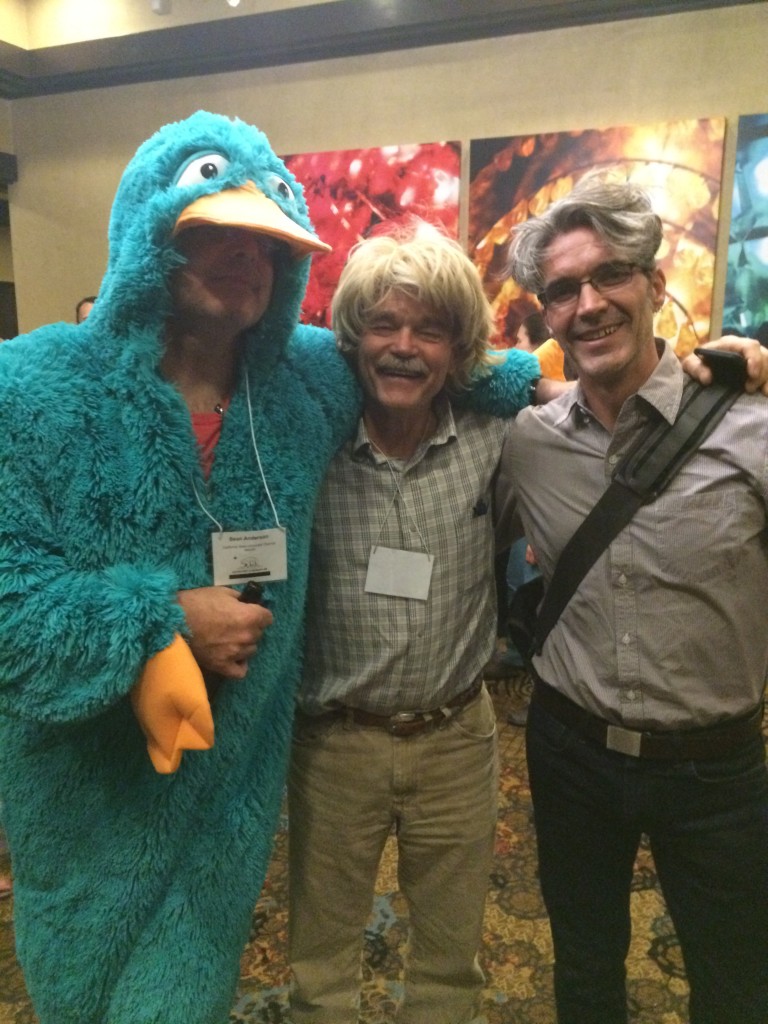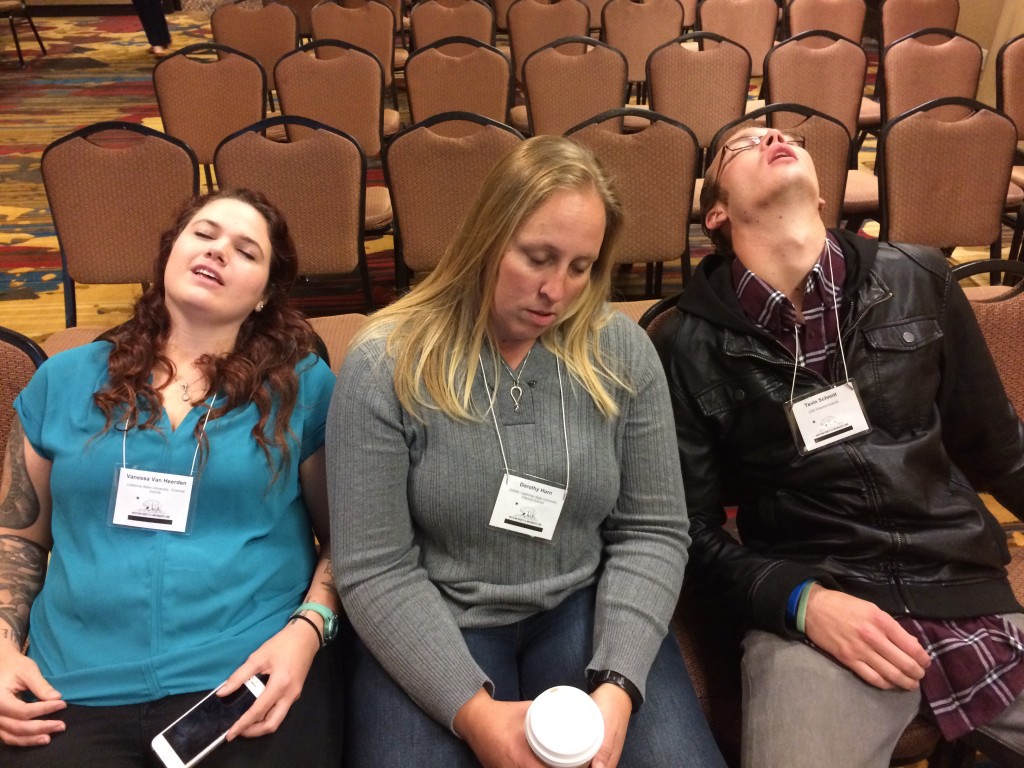Posts
Refugio Spill Talk at WSN
/in /by Sean AndersonLast weekend our sandy beach troupe made the long (6.5 hour) drive up to Sacramento for the 96th annual meeting of the Western Society of Naturalists. This is a core meeting for our research group and one of the few meetings we attend every year, rain or shine. This year’s meeting saw several of our students and professors presenting their recent work related to our continuing efforts to monitor and explore the sandy beaches of southern California and the greater Pacific.
I presented our research group’s first formal academic talk about the ecological and socioeconomic impacts from the May 2015 Refugio Oil Spill in northern Santa Barbara County. The abstract of our talk and my actual presentation are below:
Ecological and Sociological Impacts of the May 2015 Refugio Oil Spill
Anderson, S.S.1*, Wormald Steele, C.L,1, O’Hirok, L.S.1, Rodriguez, D.A.1, Spaur, P.A.1, Schmitt, T.J.1, Tillman, C.1,2, Pratt, R.T. 1, Newell, A.L.1, Anderson, S.S.1 and Anderson, G.D.3
1 – California State University Channel Islands, 2 – Moorpark Community College, 3 – Oaks Christian Middle School
The Plains All American pipeline rupture on May 19, 2015 spilled an estimated 79,000 l (21,000 gal, 500 bbls) of unrefined crude oil onto Refugio State Beach (Santa Barbara County, California) and into the Pacific Ocean. Heavy littoral oiling affected Refugio and El Capitan State Beaches immediately. Highly variable tarring episodes impacted beaches as far as 170 km from the break over the ensuing weeks, creating a unique arena in which to test tarring impacts. Sandy beach ecosystems dominate the shorelines of these regions and so bore the brunt of the impacts from this spill. Infaunal diversity dropped and heretofore unobserved conspicuous dead Emerita analoga (sand crabs) were common in the swash zone across several beaches although an independent decline in sandy beach infaunal diversity/abundance across the region over the past year made impact detection problematic. Laboratory experiments confirmed the toxicity of deposited tar to developing Emertia embryos, juveniles, and adults. The spill had immediate but mostly ephemeral effects on people: reducing summer spending at the most heavily tarred beaches by an order of magnitude, halving the number of people who felt Santa Barbara-area seafood was safe to eat, and bolstering support for offshore drilling bans.
I am at a loss for why my voice was so fried during my above talk. It may have something to do with the student auction I co-hosted (along with the good Dr. Mark Steele from CSU Northridge) the night before, but then again it was generally a regular Saturday night…

Drs. Sean Anderson (disguised as Perry the Platypus), Mark Carr (disguised as Marilyn Monroe), and Mike Dawson (disguised as a UC Merced Professor) engage in witty banter in the wake of the Student Auction. Western Society of Naturalists Meeting, Sacramento, CA on November 7, 2015.
Clearly, my talk enthralled all who attended…

Vanessa, Dorothy, and Tevin are enlivened by my incredibly interesting and engaging talk on the Refugio Oil Spill.
WSN!
/in /by Dorothy HornPipeline Repairs Will Take A Loooong Time
/in /by Sean AndersonNews is just breaking that the repair of the embattled trunk line delivering crude oil from Refugio’s onshore distribution facility to refineries in Kern County that ruptured last May and caused the Refugio Oil Spill may take a long, long time to repair.
While I have found such estimates to almost assuredly be overblown, the sheer order of magnitude (years) is quite noteworthy here and speaks to aging infrastructure that may not have been as well maintained as we would all like to think. The infrastructure crisis in the U.S. in not just a government issue: the private sector can be similarly cheap. We last, most dramatically, saw this with BP’s “run to failure” policy in Alaska and across various other global oil production units.

An aerial photo of the section of pipeline that ruptured on May 19, 2015 and ultimately sent crude oil into the ocean at Refugio State Beach. Federal investigators found extensive corrosion in that section of pipe. Image: John Wiley.
From the Pacific Coast Business Times:
excerpted from Alex Kacik’s November 5th 2015 piece Refugio oil spill pipeline might take five years to get back online
The pipeline that was responsible for the Refugio oil spill in May could take up to five years to get back online and the best-case scenario is 18 to 24 months, according to California Economic Forecast Director Mark Schniepp.
He spoke to a room full of the biggest oil players in Santa Barbara County, public officials and members of the Chumash on Nov. 5 about Santa Maria and the region’s economic future, which are inextricably tied to the oil and gas industry.
If Houston-based Plains All American Pipeline’s Line 901 remains dormant over the next three years, Santa Barbara County could lose out on an estimated $74 million, Schniepp told about 100 people at the Economic Action Summit at the Radisson in Santa Maria.
The county would potentially miss out on about $5 million in federal royalties, $37 million In property taxes, 155 jobs and $32 million in worker income.
“This could probably be expedited and, given the economic impacts I’m about to show you, it ought to be expedited,” Schniepp said about making Line 901 operational. “There are a lot of claimants losing a lot of dollars and will lose them going forward.”
…Exxon is the region’s biggest oil operator, producing nearly 30,000 barrels per day that generated nearly $1.2 billion in revenue last year. Exxon was on pace to make an estimated $636 million in Santa Barbara County in 2015, Schniepp said, but it has only generated an estimated $216.6 million because production was shut down after the May oil spill. About 65 jobs may be transferred to other Exxon facilities, he said
Santa Barbara County recently rejected Exxon’s emergency application to truck oil to refineries because the company did not prove that an emergency exists, the county said.
“It seems that we should probably do what we can do to get things up and running in order to enjoy the benefits we had prior to the shut down,” Schniepp said. “People are going to feel it.”
…Since the oil spill, public officials have called for more vigilant pipeline regulation, requiring the use of new technology and improving oil spill response. Gov. Jerry Brown signed three bills that require the California Fire Marshall to review oil pipeline conditions every year, not every five years as mandated by more lax federal regulations; aim to make oil spill response faster and more effective; and force intrastate pipelines to use the best-known technology such as automatic shutoff valves. Line 901 is an interstate pipeline.
Back on the Island
/in /by Zack BuckleyWell I am back on the island to continue my research and something amazing happened, I found the GPS unit i lost on my last trip with all my data! This eliminated the hours of recounting the same trees over again and helped get me back on track to have all my data collected by the end of January so I can get down to some serious data analysis. Here is a snapshot of a GIS map of the data myself and my two partners, Brice and Dulce, have collected so far, with much more to come.
We made news!
/in /by Dorothy HornWeekend #2
/in /by Zack BuckleyIt was another great weekend out on the island, unfortunately most of my data from the weekend was lost but it was a beautiful weekend with an unusually low amount of wind. It made for quite a hot weekend but the views were still magnificent. By the end of my next trip I should be mostly done counting trees on the hillside I am currently working on and be moving down into the canyon.
Santa Rosa Island Research Station
/in /by Dorothy HornThis last weekend I was able to go out to the Island with Dr. Clare Steele and the Conservation Biology class. I was able to enjoy the plethora of knowledge and experience it has to offer. Santa Rosa Island is beautiful but in a period of restoration and recovery from its long history of human inhabitants.
I was able to help Michaela Miller with her capstone of Marine Debris collection along some of the remote beaches of the island including Arlington Canyon, Sandy Point, Cluster Point and Skunk point. I also visited Bechers Bay and Water canyon to collect sand samples and test for micro plastics. All in all it was an excellent weekend! Overall every sand sample I collected had microfibers and microplastics in it.











